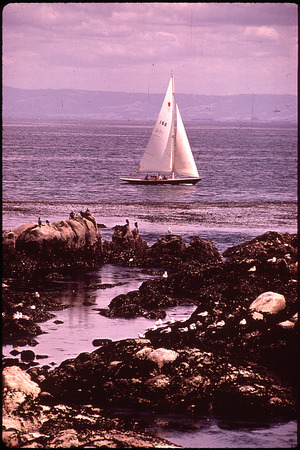Edward F. Ricketts State Marine Conservation Area facts for kids
The Edward F. Ricketts State Marine Conservation Area is a special ocean area that helps protect marine life. It's one of four small protected ocean spots located near the cities of Monterey and Pacific Grove in California. These areas are at the southern end of Monterey Bay on California’s central coast. Together, these four areas cover about 2.96 square miles (7.7 km2) of ocean.
In these special areas, most fishing and taking of any living ocean resources is not allowed. However, people can fish for finfish with a hook and line for fun. Also, giant and bull kelp can be harvested for commercial use under specific rules.
Contents
Protecting Our Ocean
These two State Marine Conservation Areas were created in September 2007. The California Department of Fish & Game set them up. They were among the first 29 marine protected areas established. This was part of the Marine Life Protection Act Initiative. This important project aims to create a network of protected ocean areas all along the California coastline.
Where is This Special Place?
The Edward F. Ricketts State Marine Conservation Area is located off the coast of the Monterey Peninsula. It sits at the southern end of Monterey Bay. This protected area covers about .22 square miles. It is directly offshore from the famous Monterey Bay Aquarium and Cannery Row.
The area was named after Edward F. Ricketts (1897–1948). He was a scientist who founded the Pacific Biological Laboratories in Monterey. This conservation area is the easternmost of four marine protected areas that border the Monterey Peninsula.
The Lovers Point State Marine Reserve is right next to the Ricketts SMCA on its west side. Beyond that is the Pacific Grove Marine Gardens State Marine Conservation Area. Farther south and west, you'll find the Asilomar State Marine Reserve. All four of these protected areas are part of the larger Monterey Bay National Marine Sanctuary.
Ocean Homes and Wildlife
The Monterey Peninsula has amazing tidepools that are full of life. These are small pools of water left behind by the tide. The sandy beaches here are used by harbor seals to have their pups. Offshore, thick kelp beds grow tall like underwater forests. These kelp forests provide shelter for many animals, including sea otters.
The State Marine Conservation Areas offer homes for many different kinds of marine life. These habitats include kelp forests, sandy beaches, rocky intertidal areas (where land meets sea), and both soft and hard seafloors.
Fun Things to Do
The beautiful ocean and natural sights of the Monterey Peninsula attract millions of visitors every year. More than 65,000 scuba divers come here. They love the easy access, the variety of wildlife, and the huge kelp forests.
Besides diving and visiting the aquarium, people enjoy Monterey Bay in many ways. They go kayaking, whale watching, and charter fishing. There are also many restaurants that serve fresh, local seafood.
California’s marine protected areas encourage people to enjoy and learn about the ocean. Activities like kayaking, diving, snorkeling, and swimming are usually allowed.
Learning from the Ocean
The Marine Life Protection Act requires scientists to study certain marine protected areas. They want to see how well these areas are working. They also want to learn more about the health of our oceans. Similar studies in protected areas near the Santa Barbara Channel Islands have already shown good results. Scientists have seen a gradual increase in the size and number of fish there.
Local science and education groups help with this monitoring. These include the Hopkins Marine Station, the Monterey Bay Aquarium Research Institute (MBARI), and Moss Landing Marine Laboratories. Scientists use different methods for their research. They do hook-and-line sampling, scuba diver surveys, and use special Remote Operated Vehicle (ROV) submarines.
Monterey Bay topics


